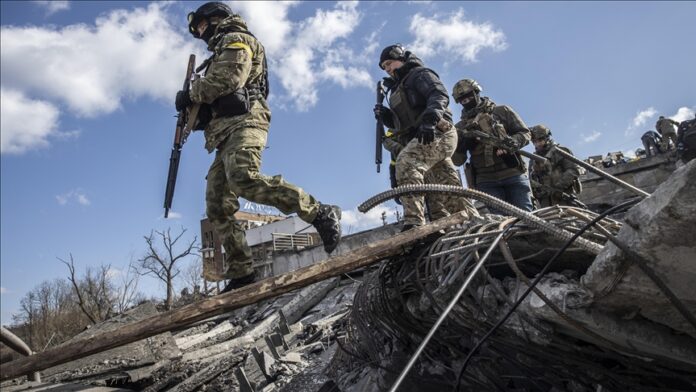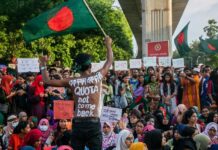End the imperialist meat-grinder! For international working class struggle against war and imperialism
Danny Byrne, ISA International Executive
(This article was first published on 26 February 2024)
The fall of the town of Avdiivka to Russian troops, who are making gains following the failure of Ukraine’s counter-offensive, quite neatly coincided with the second anniversary of this epoch-defining conflict. To fully appreciate its historic significance, it is worth looking back at the world and its reaction, as the war loomed this time two years ago.
Russian troops massed on the Ukrainian border in the final months of 2021, preparing to invade, but few were prepared to believe what was about to happen. Hapless bourgeois media commentators were virtually all in agreement that Putin would not “go there”. Surely he couldn’t? Yet Russian tanks rolled over the border on 24 February 2022, to start the deadliest war in Europe since WW2.
As has been the case throughout history, global capitalism’s supporters overestimated the fragile stability of this crisis-ridden system, which has been immersed in a new age of disorder. Not only did the invasion happen, but the bloody war which still rages on was not an aberration. On the contrary, it has helped to set the tone for our times.
It encapsulates an era which has jettisoned the previous geopolitical equilibrium and its “rules-based order”, and in which predatory imperialism is increasingly exposed as it threatens to drag humanity through an epoch of war and bloodshed. Events unfolding in the Middle East are adding more bloody scenes to this picture, as have the mountains of bodies stacked up by wars in Ethiopia, Nagorno-Karabach and elsewhere in the last short period.
Working class and young people, and socialists around the world should heed the warning of this war. Among its many lessons are the need not to underestimate the degree of disorder being built up in the 2020s, or to underestimate the depravity of capitalism and imperialism.
Perhaps the most important lesson is the urgency of rebuilding the organizations and struggles of the international working class, and arming them with revolutionary socialist policies and leadership.
A previously unthinkable conflict on European soil
Capitalism has never — and can never — be a system without wars. Even in epochs marked by lower levels of armed conflict, wars have continued to happen, and the ruling class has continued to pump trillions of dollars into preparing for more wars. This was the case throughout the period of unchallenged “unipolar” US world domination which followed the collapse of Stalinism.
However, during this period, when planning for warfare in the 21st century, very few foresaw a war like this one, and Western political and military establishments certainly did not prepare for one. The prevailing doctrine for the “wars of the future” was one of a move away from “close combat”, meat-grinder trench warfare, and towards conflicts dominated by methods of a long-range, aerial, unmanned, technological, cyber, and economic nature. Only four months before the war in Ukraine began, Boris Johnson confidently told the UK parliament that “the old concepts of fighting big tank battles on the European landmass … are over”.
Instead, the most important war in Europe for decades has more resembled World War I, with “meat grinder” close combat for control of rat-infested trenches, where thousands are slaughtered to claim a few hundred square meters of ruins. While the Ukraine conflict is undoubtedly a modern one, with the most modern conventional weaponry around in full use, and where drones and cyber-warfare play a greater role than ever before, the most coveted kit is currently the simple artillery shell, which has not changed much in a hundred years.
The initial stages of the war, marked by the brutality of the invasion and a Ukrainian armed resistance which was much stronger than many expected, awoke some “war enthusiasm”, especially in Western countries, as millions of ordinary people were moved by genuine solidarity and sympathy with ordinary Ukrainians. However, the reality two years on has seen weariness and opposition to this bloody conflict grow, both internationally and in Ukraine itself.
Phases of the War
The war has seen numerous twists and turns, and passed through several phases. The first was that of the humiliating failure of Russia to carry out its initial mission: the conquering of the entirety of Ukraine, including suppression of the regime. Badly prepared troops, who were reportedly sent over the border with special uniforms in their bags to wear on a soon-to-come victory march through Kyiv, were bogged down and out-maneuvered. Ukrainian morale and motivation was sky-high, as thousands queued at army recruitment centers and volunteered to assist the military in manifold ways.
Within weeks, Putin was forced to announce a change of plans: his troops would withdraw from the outskirts of Kyiv and Northern Ukraine, in order to focus on the “liberation” of the Donbass. Amid reports that Western leaders had vetoed a peace deal around this time, Russian forces advanced slowly but steadily, occupying around 80% of the Donbass (Lukansk and Donetsk provinces) in the following months before stalling and becoming bogged down in a battle for the city of Bakhmut that was to last over 6 months.
The tide turned dramatically in September 2022, when Ukrainian troops launched a surprise offensive which overran Russian lines in the North-Eastern Kharkiv region, taking back up to 3,000 square kilometers in a few days, and forcing unprepared Russian troops to flee several significant towns and cities. While lines stabilized, Russian forces spent the following period on the back foot, and in November were forced to withdraw from Kherson in the south, a major city which it had quickly taken after the invasion, with the help of local collaborators.
The next phase was one of stalemate, with the only exception being the taking of Bakhmut, which finally fell to the Russian military in May 2023. All in all, while there has been no ebbing of the bloodshed, the front lines have moved only marginally since then.
This is despite the great expectation generated around Ukraine’s summer counter-offensive. It represented the apex of Western military assistance to Kyiv, with 12 armored brigades prepared, 9 of which were directly trained and prepared by NATO, and boasted a plethora of Western tanks, armored vehicles and missiles. Western enthusiasm reached fever pitch when the counter-offensive coincided with the Putin regime’s biggest internal crisis — the Wagner mutiny led by Yevgeny Prigozhin. But in the months that followed, tens of thousands perished with precious little to show for it. In fact. Ukraine gained only half as much territory as Russia had taken during its offensive operations earlier in 2023.
As the counter-offensive petered out, due in significant measure to well laid Russian defenses, Russian troops began to slowly advance and remain on the front foot at the time of writing. Their latest win in Avdiivka is significant, and by far the biggest settlement to change hands since the fall of Bakhmut.
An inter-imperialist proxy-war
What has led to the current turnaround? While many factors, not least falling Ukrainian morale, play their part, a crucial one has been the ebbing flow of military aid to Zelensky. The disastrous counter-offensive has frustrated any hopes of imminent Russian defeat, and emboldened the establishment political voices which push back against Western government’s pro-Ukraine war policy.
These voices, drawn largely from utterly reactionary sectors, have their clearest expression in the US Republican right. Their “isolationism” (a misnomer) does not reflect an opposition to US imperialism asserting itself by any means. In reality, they coalesce around the idea that this is the “wrong war” for US imperialism today, and favour a more rigid focus on the conflict with China (which Marxists understand is at root the same geopolitical struggle as that being played out in Ukraine).
Zelensky, Biden and others have publicly blamed the US Congress and its failure to approve new military aid packages for Kyiv for Ukraine’s defeat in Avdiivka. In the closing stages of the battle for the city, Russia was reported to enjoy a 10–1 artillery advantage, making it impossible to hold the line.
This underlines the depth of the Ukrainian regime’s dependence on Western imperialism for its war effort, and the decisive role played by US imperialism in particular, in this war. This is part of the picture, identified by ISA since the war began, of this war being at root an inter-imperialist proxy war. While it is Russian and Ukrainian troops (overwhelmingly) doing the fighting and most Ukrainians understand the war as one to defend their territory and independence, the real roots of the war’s origins and meaning lie not in a “local” conflict, but in Russian imperialism’s (a crucial part of the China-led imperialist Cold War bloc) deep-seated conflict with US-led Western imperialism. Putin’s invasion represents not the whims of a “madman”, but decrepit Russian imperialism, which has been on the losing end of history for decades, reasserting its interests in a new age of disorder, dominated by geopolitical (aka inter-imperialist) conflict.
The billions of dollars in different types of aid to Ukraine has never represented an ounce of concern for Ukraine’s people or its right to exist. This is “money well spent” (and other people’s blood well spilled) by Western imperialism in defense of its ugly struggle for world domination. They have sought to use this war to decisively weaken Russia, and to send a clear warning to China with a view to brewing conflicts in the Pacific arena. Within this, US imperialism has also used the war to solidify its leading position within the West and NATO.
On the other side, Chinese imperialism’s clever diplomacy cannot obscure its backing for Russia, which is by far its most important ally on the world stage. While avoiding open direct military support and assistance, it has served as an economic lifeline for Russia, helping to neuter the impact of historic sanctions. It has also used the conflict to establish an even more dominant position within the China-Russia relationship, with Putin totally dependent on Xi’s support and backing. The war has also led to a solidification of the wider China-led bloc in the world, with regimes like Iran and North Korea stepping more firmly into the fold.
On top of the bloodshed, this fundamental nature of the war assigns it a deeply reactionary character. Working class people in Ukraine, Russia and internationally have nothing to gain from the war or a victory for either side. Russia succeeding in annexing Ukrainian territory will strengthen and embolden the Putin regime and its allies, whetting the appetite for further barbarity. On the other hand, the NATO-backed Ukrainian regime defeating Russia would be an historic victory for the equally barbaric West, and lead not to liberation for the Ukrainian people, but to the entrenchment of an ultra-militarised reactionary vassal regime. Only international working class struggle for peace and socialism and against imperialism can overturn the reactionary juggernaut in this region.
Does Russia have the initiative in 2024?
Western analysts are beginning to cohere around the idea that 2024 will be “Russia’s year” in this conflict. As well as their modest gains on the battlefield, they are alarmed at indications that Russia is winning the “war in the rear”, essentially the race of military production and procurement. Its inescapable man-power advantage is added to by a vast military industrial capacity which has spent many months on “war tempo”, with surging war production. Estimates are that 7.5% of Russian GDP is now spent on the military, with a massive 2.5% of the total population employed in the military industrial complex. On top of this, while Western supplies to Ukraine stall, Putin has secured significant new supply agreements with North Korea and Iran.
This is alongside the deepening crisis in Ukraine, which has many expressions. Zelensky celebrated the new year with the sacking of the army’s chief of staff, Valeriy Zaluzhny, after months of conflict amid rumours the latter would challenge Zelensky — and maybe beat him — in the next presidential election, now indefinitely postponed. After the failed counter-offensive, Zelensky was forced to sack his entire team of regional military recruiters as widespread corruption saw thousands of desperate draft dodging Ukrainians flee the country unhindered.
The situation which existed at the start of the war, with a population keen, willing and eager to fight, has been transformed to its opposite. Army recruiters are more often met with fear and hostility than with enthusiasm. Zaluzhny’s push for a new round of mobilization was bitterly fought by political figures wary of the changing mood among the population. Protests have even repeatedly taken place, most recently led by women demanding shorter periods of service for those on the front line, echoing similar protests which have arisen sporadically in Russia through the course of the war.
In contrast, a superficial look at Moscow would give the impression that Putin is “sitting pretty”. As fake “elections” approach which will keep him in power, his two most prominent potential opponents — Prigozhin and Navalny — have both recently ended up in body bags. However, this “strong position” must be taken with a large grain of salt.
Putin’s actions may seek to project strength but in reality are desperate moves to shore up an increasingly dictatorial regime. Despite Ukrainian problems in the war, Russian troops will not simply roll through, and a decisive victory for Putin’s maximalist war aims is as unlikely as a total defeat. Moreover, the front will continue to demand more and more meat for the grinder, which will continue to exert significant pressure on Russian society, added to by increasing numbers of direct Ukrainian attacks within Russia itself. While the regime’s machine of repression has functioned so far as intended, in terms of suppressing popular discontent and protest, the memory of how easily Wagner columns rolled through Russian territory on their famous “march to Moscow” will remain as a cloud over Putin’s head.
Fear of Trump 2.0
Events in 2024 are difficult to predict, not least because of the crucial US presidential election campaign. The prospect of a second Trump presidency, which the pollsters currently predict, has provoked severe unease in European capitals. Trump’s incendiary remarks from rally podiums, to the effect that he will abandon NATO allies that don’t “pay up”, have only added to this.
This has led to renewed calls for European imperialist powers to further accelerate their beefed up militarist policies, in order to “stand on their own two feet”. This push, in line with the interests of ruling classes, will undoubtedly deliver some results. Already, it has been announced that Germany is one of 18 NATO powers (up from 11 last year) expected, for the first time, to meet the alliance’s target of military spending over 2% of GDP this year.
However, US leadership within the western imperialist bloc is more decisive now than ever, and the prospect of EU powers “going it alone” in successfully backing Ukraine in a full-scale war with Russia ultimately does not appear to be realistic, given the current pace of rearmament and the reality on the battlefield. In this context, pressure for a negotiated settlement, which has been ruled out until now by Zelensky, may increase significantly, if more US military aid does not materialize. However, whether Putin would be interested in such a deal while he has the initiative is another question altogether.
Moreover, what the concrete policy of a hypothetical Trump presidency in relation to Ukraine would look like remains to be seen. While Trump is riding a wave of opposition sentiment to the war, and is undoubtedly personally hostile to the Ukrainian regime, he is also a committed Cold Warrior who will not fail to understand the war’s significance to US imperialism’s global power struggle with China. How will his famous pledge to impose a “peace plan” on both sides to end the war in 24 hours will actually interact with the reality of the conflict once in power?
What is clear is that beyond the Presidential suites around the world, people are increasingly turning against this war. A major Europe-wide poll in February showed that just over 1 in 10 Europeans (across 15 countries) believed it was possible for Ukraine to win. In the same poll, significantly more people wanted their governments to “Push Ukraine towards negotiating a peace deal” than to “Support Ukraine in regaining territories”. To this must be added the masses of the “global south”, the bulk of whom never supported this war in the first place, and who have been further enraged by and alienated from the cause of Western imperialism by the horrific slaughter underway in the Gaza strip.
For working class struggle against a new age of bloodshed
For socialists, it is crucial that right-wing populists are not allowed to posture as the only (fake) “anti-war” voices. This is a real danger, given that much of the reformist Left around the world, from Podemos in the Spanish state, to the “squad” in the US, to the Swedish Left Party, has capitulated to the pressure of the war and abandoned any pretense of an anti-war, internationalist anti-imperialist position of the principled Left, including opposition to NATO.
Socialists must take a clear stand against this war, based on an understanding that neither of the imperialist blocs currently fighting for world domination represents the interests of working class and oppressed people. We call for the end to the war, for the withdrawal of Russian troops, the right of Ukraine to exist as an independent nation free from domination by imperialism of any kind, opposition to NATO, and for the right of self-determination of all minorities and regions within Ukraine.
Only the working class in Russia, Ukraine and internationally can put an end to the war and Putin’s dictatorship. World War One was ended by the revolutions in Russia 1917 and Germany 1918. A major factor forcing US imperialism to withdraw from Vietnam was growing the mass protests in the US and internationally, linked to a period of mass workers struggles. Today, strikes and protests on living conditions, against austerity and privatisations should be linked to the human and economic costs of militarisation and war, and support protests against the war and its effects by family members and youth. As with all struggles against oppression, this a struggle against the capitalist system and its governments.
The fight for this programme must be part of a bold rallying call to the working people of the world to organize and struggle against the dragging of humanity towards ever-greater war and bloodshed. As the Middle East is showing us today, this war is not the last one which this decadent system will foist upon us, and the danger of wider military conflagrations is great, as the imperialist not-so-Cold War heats up.
Society is becoming saturated with talk of war and the preparation for war, and this will have an important impact on consciousness. Swedish young people collapsed a mental health phone helpline after the head of the armed forces issued a prominent warning to the country to “mentally prepare” for war. UK Defence Secretary Grant Shapps declared that we are experiencing a shift from a “post-war to pre-war world”. On the other side of the Cold War divide, Putin crony Margarta Simonyan, the editor-in-chief of Russia Today, declared that World War Three will happen without fail, and it will happen “in the near future”.
ISA makes no prediction that World War 3 is “around the corner”. But given the dynamic of the world situation and the powerful processes driving events, it would be a dereliction of duty not to recognize the system’s deeply dangerous direction of travel. The global multi-national, multi-racial, multi-gendered, working class — the only inherently internationalist force on the planet — must resist this.
The banner of peace and socialism must be raised high, the banner of hope for a better future.




